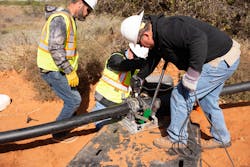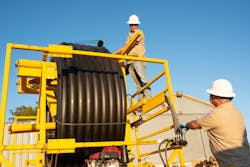Industry Fixes Texas Pipelines Split by Historic Freeze
The February 2021 winter storm Uri that hit Texas did more than bring record setting cold temperatures. It also stopped water flowing to the three two rural communities of Carey, Northfield and Aspermont, which are, respectively, about a two-or four-hour drive south east from Amarillo. The broken water pipe problem was solved by the efforts of a group of high-density polyethylene (HDPE) pipe companies, and the industry’s trade association.
“For several years, we’ve had leaks in our 14-inch line in Carey Northfield,” said Randy Whiteman, general manager of the Red River Authority of Texas (Wichita Falls, TX), which provides water to unserved or underserved areas in the Red River Basin, operating 33 different water systems across North Texas. “And the cold snap was literally the straw that broke the back of the water supply line.”
In Aspermont, the population of fewer than 1,000 faced the same problem. The main pipeline that brings potable water into the town froze and broke.
“These types failures are occurring more frequently every year,” said David M. Fink, president of the Dallas-based Plastics Pipe Institute Inc. (PPI). “The cast iron pipe and steel pipe commonly used years ago are becoming more brittle as they age.”
PPI is the major North American trade association representing the plastic pipe industry, which named the efforts in Aspermont, Carey and Northfield Project of the Year for its Municipal & Industrial Division.
“Our area was also hit very bad by winter storm Uri, but in Aspermont, Carey and Northfield, it was a catastrophe,” Fink continued. “In the panhandle, the month started off warm, hitting 80ºF. But on February 10, the temperature dropped below freezing and stayed in the teens and mid-20’s for more than the next 10 days. They did not have any readily available alternative to clean water. We were pleased to help with the solution.”
In both areas, the old pipe has been replaced with HDPE pipe.
“We became aware of the need from one of our member companies, Dow, by Dell Doyle, who also serves on several of our committees and whose family is from Aspermont,” explained Fink. “We knew that because of the vastness of the areas that a significant amount of pipe - about 8 miles - would be needed, which would strain the budgets of Red River and Aspermont. That is why we called upon our members to pitch in."
Dow was prepared to donate the resin to make the pipe, and Pipeline Plastics, a company with a handful of manufacturing plants in West Texas, also contributed. McElroy Manufacturing trained workers for the Red River's Project while Modern Dispersions provided carbon black, a key ingredient added to the resin.
“We have only 230 customers in Carey Northfield and each and every one of them is important to us,” said Whiteman, ”but the logistics and the terrain do present a big problem.”
The broken 14-inch cast iron line was buried during the 1930s.
“The old pipe was 9 feet down, which is very difficult for us to maintain, especially when it broke, which was quite often,” said Fabian Heaney, assistant general manager of the Red River Authority of Texas. “We estimated that this line leaked more than 3 million gallons of drinking water in one year. So, this replacement will help save much of our precious water.”
Eight hundred feet of the 4-inch diameter PE 4710 HDPE DR11 pipe came coiled on each reel. By digging the 4-foot-deep trench and uncoiling the pipe in a continuous flow, the four-man crew was able to install more than of 2,600 feet a day of new HDPE pipe even thought this was the crew’s first time. Connecting one coil of pipe to another was done using a McElroy fusion machine. This heat fusion provides a leak-free joint.
“Every water line is critical,” said Camille George Rubeiz, P.E., F. ASCE, Co-chair, HDPE Municipal Advisory Board and the senior director of engineering, municipal and industrial division of PPI. “And in these areas, reliability is first and foremost. Repairs are almost impossible. One pipe break can knock out a community’s water supply for weeks. This HDPE PE 4710 pipe has all the properties to provide the benefits of a superior pipeline for decades."
“Plus, it can be readily used for horizontal directional drilling, which is what Aspermont will use when installing the pipe under the Double Eagle Fork Brazos River," Rubeiz said.
Texas state representative, David Spiller (House District 68), who serves on the state’s County Affairs and Land & Resource Management Committees, visited the Carey Northfield area site while the RRA crew was installing the pipe.
“Well, the pipe as it's designed is interesting and it's flexible," Spiller said. "It’s obvious that the material allows the pipe to function properly yet enables it to be quick to install. I can see that it’s much easier for the crew when they have a flexible pipe to install than rigid pipe, plus it follows the land.”
The 919 residents of Aspermont were hit by the same cold wave with the same results.
“In early February of this year we experienced extreme cold spells,” said Steven Ellis, Aspermont Mayor, “and the water line that carries our water from another county completely froze. It was devastating and put our city without water for 13 days, and on low water notice for another 20-something-odd days.”
The city's pre-chlorinated water comes from Winfield, which lies around 2 miles east of a river crossing where the issue was felt the greatest for Aspermont. Lorenzo Calamaco, Aspermont city administrator, said 1,500 feet of pipe froze during the storm, jeopardizing the water source for the city.
“It was attached to the road bridge crossing the Brazos River and completely froze and burst, so that's why we had to put in a temporary bypass line in March," Clamaco said. "We used Pipeline Plastics 8-inch diameter, PE 4710 DR 11 pipe. We had to put it above ground, but to keep the pipeline from freezing we're going to bore it underneath the Brazos using that pipe. The HDPE pipe is perfect for that plus it can handle our water pressure of 120 psi.”
Utilizing Dow’s CONTINUUM Bimodal Polyethylene Resins to make the pipe was also an important consideration.
“The bimodal HDPE material donated by Dow exceeds industry performance standards and offers increased reliability,” explained Dell Doyle Ph.D., TS&D scientist at Dow. “Pipes manufactured using our CONTINUUM resins not only offer the longest lifecycle of any potable water pipe in virtually any climate, they also allow for excellent resistance to chlorinated water and slow crack growth with the highest chlorine resistance (CC3) rating required in AWWA C906-21.”
“It is very important that the chlorine category requirement CC3 for potable water applications has been added to the C906-21 materials section,” Rubeiz explained. “Many utilities use chlorine and chloramines as residual disinfectants in the potable water system.”
Jeremy Hohn, director of energy sales for Pipeline Plastics, said the company acted quickly to fix the interruption.
“Hearing stories from the affected workers and residents, it was very disheartening that these communities had to turn to bottles and trailers of water to try to keep basic functions going," Hohn said. "Water is life for their community, so this team of PPI members was able to partner together and restore the water service, which literally brought life and energy back to these communities.”
In order to meet the need of more than 42,000 feet of 4- and 8-inch HDPE pipe, Pipeline Plastics, which was also affected by Uri and lost power for many days, was able to change its production schedule to meet the needs of Red River Authority and Aspermont.
“When we realized we didn't have water, of course it's a horrible moment for everybody," Ellis said. "You're talking about losing drinking water to flush your commode, watering animals, and the main concern is drinking water. We started getting a lot of phone calls from people contacting us about how they can help, and how we could all pull together and try to make things work. We had people go and pick up water from different cities, and bring it back here to hand out. The community really pulled together during that time.”
Calamaco echoed that sentiment and noted the value of the companies that helped get the pipeline restored.
“We're a small community and with the help of partners like Dow and Pipeline Plastics, we were able to get the water going, and they really helped us," Calamaco said. "We didn’t have water for 13 days and without help from PPI and partners like Pipeline Plastics and Dow who knows how long we'd be out.”
About the Author
Steve Cooper
Steve Cooper is a writer for SCA Communications. Cooper can be reached at [email protected].


